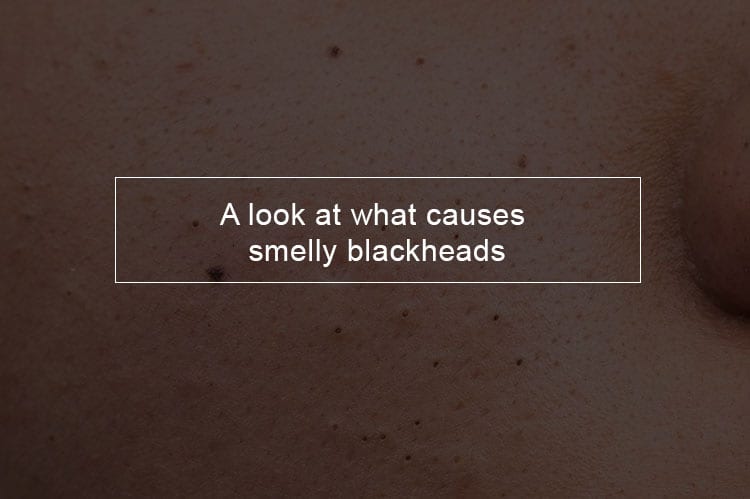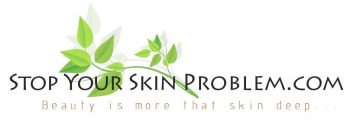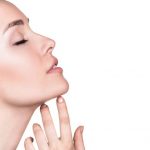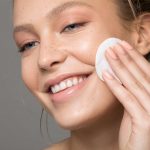
The most common reason why blackheads stink is due to lack of proper skin care. Cleaning your face with a mild cleanser helps to get rid of bacteria, excess oil and dirt which otherwise would clog your pores, making your blackheads stink. Bacteria, dead skin cells, sebum plugs, picking and squeezing the blackheads can also make the blackheads develop an odor.
When shed skin cells, excessive sebum and bacteria clog pores; it can result in acne. Blackheads are clogged pores that are exposed to the air, oxidizing the surface of the plug turning it black. Malodorous acne isn't a prevalent problem, although the discharge from blocked pores may have a little odor.
What are blackheads?
Causes of smelly blackheads
Blackheads are tiny, dark lesions that appear on the epidermis, often on the face and neck. They are a sign of mild acne, but they can show up without other indications of acne being present. They contain oxidized melanin, the dark pigment made by cells in the skin. Acne is a skin disease that affects a lot of people. Handling blackheads correctly can help inhibit the development of more severe acne.
Blackheads are a type of comedo. Comedones occur when the skin pores get clogged with dead skin cells, sebum, and dirt. Due to oxidation the top of the blackhead, which is visible on the surface of the skin, has a dark color. When these pores are clogged, the dead skin cells in the pore react with oxygen in the air and turn black, forming a blackhead.
It is often mistaken with trapped dirt, but the growth of blackheads is not related to the cleanliness of the skin. Other kinds of acne are usually closed, but with blackheads, the skin surrounding the clogged pore opens, letting air in making the collected sebum oil or dead skin cells to oxidize and turn black or sometimes yellowish.
Blackheads frequently appear on the face, back, neck, chest, arms, and shoulders as there are more hair follicles in these regions.
Facts about blackheads
1. Blackheads are composed of oxidized melanin and not trapped dirt.
2. Squeezing or scrubbing them can worsen the condition.
3. To lessen blackheads, avoid applying oil-based skin care products, humid environments, wearing tight clothes, and skin products that comprise alcohol.
4. They appear when hormonal fluctuations lead to the increased generation of sebum, an oily substance, by the oil glands under the skin.
Causes of blackheads
Some factors can raise the chances of developing blackheads.
- Age and hormonal fluctuations are an important factor. Like other indications of acne, blackheads are most frequent during puberty, when the fluctuation in hormone levels triggers a spike in sebum generation. However, they can appear in people of any age.
- Androgen, a male sex hormone, triggers secretion of more sebum and a higher turnover of epithelial cells during puberty. Both boys and girls get elevated levels of androgens during adolescence.
- After puberty, hormonal changes associated with menstruation, pregnancy, and taking birth control pills can also cause blackheads in women.
- After puberty, hormonal changes associated with menstruation, pregnancy, and taking birth control pills can also cause blackheads in women.
- Overproduction of epidermal cells by the body can cause blackheads.
Other factors include:
- the blocking or covering of skin pores by cosmetics and clothing.
- sweating heavily
- shaving and other activities that open up the hair follicles
- some health conditions, like stress, polycystic ovarian syndrome (PCOS) and premenstrual syndrome (PMS) can cause blackheads
- medications that promote rapid skin cell turnover
- use of some steroid-based drugs, like corticosteroids
- Contrary to popular belief, poor hygiene doesn't directly cause blackheads. Excessive scrubbing of the skin in an attempt to remove them can make acne worse
What makes blackheads smell bad?
Sebum Plugs
Generally, sebum travels toward the surface of the epidermis and serves as an emollient to maintain moisture and stop the movement of germs and chemicals into the skin and body. But excessive sebum generation, together with dead skin cells, can clog your pores. Occasionally it can develop a kind of odor.
Dead Skin Cells
As new skin cells develop older ones are shed. The external layer of skin cells, the stratum corneum, comprises of about 20 layers of dead skin cells that gradually shed. But when one has acne, dead skin cells can get trapped in pores, and instead of shedding, they form a clog with the sebum in the hair follicle. They can start to decay, contributing to the odor problem.
Microorganisms
Bacteria are found on the skin, and some kinds are beneficial. But harmful microbes, like the Staphylococcus aureus bacteria or herpes simplex virus, can also be found on the skin surface. Blocked pores present a feeding ground for these microbes, and the pores can get infected as the germs attack the substances in the pore. The odor might not be very noticeable. If it is, this can be an indicator of a more serious infection. Visit a doctor immediately.
Picking and Squeezing Acne
Picking and squeezing blackheads and pimples introduces dirt and more germs into the pores, which can make odor worse. Bacteria can be carried from infected pimples to blackheads that were not infected, spreading infection across the face.
Acne pus odor
If a small acne pimple breaks open and releases the pus, it is not likely you will notice any odor. The amount of odor-emitting chemicals is generally too low to cause a noticeable odor. Nonetheless, because larger acne nodules and cysts have a bigger volume of pus and bacterial debris, you might fleetingly notice an odor when they drain. Delicately washing away the pus with a mild skin cleanser and water will eliminate this temporary odor.
Bacteria
Bacteria is typically present on the skin, and some of it is beneficial. However, harmful bacteria, such as Staphylococcus aureus, can also be present on the skin. Blocked pores offer a feeding ground for the bacteria and can get infected as bacteria attack the materials in the pore. The odor is not likely to be very noticeable. In case it is very noticeable, it may indicate a more severe infection, and you should see your physician, according to medical studies.
How to Prevent Blackheads?
Blackheads are simple to self-diagnose, and on their own, they are not usually a cause for concern or reason enough for a person to seek help from a dermatologist. Many people are tempted to extract blackheads, but the real trick for getting clear skin is prevention. Preventing blackheads is as easy as having a regular washing regimen. Cleaning your face once in the morning, before going to bed, and after a workout, can help prevent oil buildup that causes clogged pores. This will also help kill off P. Acnes bacteria, and ensure that your pores are clear. If your blackheads have been difficult to stop or continue to come back, there are treatments available.
Blackhead treatment options
Before looking at how to treat blackheads, it’s important to examine products that claim to help but are only a temporary fix.
Self-extraction
It can be quite tempting to squeeze blackheads, but this can wreak havoc on your skin. It can cause inflammation, open your skin up to infection resulting in acne scarring.
Using pore strips
Pore strips are also a popularized method of blackhead removal, but they don’t do much in treating blackheads. While they can get rid of the tip of the plug in the comedone, all the sebum, dead skin, and bacteria built up in the pore are left intact, indicating a new plug will form easily. While they can temporarily make pores look smaller, they do nothing to stop blackheads from recurring.
Over washing the affected skin
Many falsely believe that blackheads can be remedied through rigorous cleansing, but this can aggravate the skin and worsen acne. Cleaning your face about twice a day is enough to slough off dead cells and keep your pores clean.
What works for blackheads?
Topical application of acne treatments
While daily cleansing of the skin can work wonders for blackhead prevention and treatment, topical ointments can help deal with this persistent skin condition.
Manual Removal of blackheads
Dermatologists use a special instrument called a round loop extractor to remove blackheads. This extractor forces the contents of the pore up, making the plug pop out of the skin. Dermatologists push the plug from various angles to guarantee that all of the clogged material is removed from the skin. Never try to remove blackheads at home with your hands. Improper removal can result in ruptured skin cell walls, which can lead to swelling and infection and produce severe pimples and acne. Squeezing these lesions can enlargen pores that get easily clogged and more noticeable, and push the infection deeper into the skin.
Light and Laser Therapy
IPL and LED therapies can reduce the appearance of pores and reduce the incidence of blackheads. The light is created to reach deep into the skin and stimulate the generation of collagen and is meant to destroy acne-causing bacteria that reside on the skin. These treatments are quite expensive and need multiple sessions, but for those with excessively large pores or severe acne, it can be quite beneficial.
Chemical Peels
Chemical peels require the application of a strong chemical solution to the skin which strips the top layer of the skin of the affected area, revealing smoother, regenerated skin cells underneath. This can help to unclog pores and remove the skin of blackheads. There are some mild, over the counter chemical peels, and doctors and certified professionals can provide stronger chemical peels if needed.
Microdermabrasion
This is a skin resurfacing procedure that utilizes abrasive material and devices to gently separate the top layer of epidermis in combination with suction tools. This dislodges blackhead plugs, opening up the pore and removing the contents.
Home remedies for removing blackheads
Exfoliate with baking soda
Mix 2 teaspoons of baking soda in a bowl with mineral water to make a paste. Apply this paste onto your nose, and massage it lightly, so you don’t harm the skin. Allow the paste to air dry for some minutes before rinsing it off with some lukewarm water. Apply this remedy about one or two times a week. Baking soda will help dry up blackheads and make your skin look brighter and cleaner. You can also add ACV to the baking-soda paste. Apple-cider-vinegar is a natural astringent and antibacterial, so it helps kill germs and tighten pores.
Apply egg whites to your nose
Egg whites are loaded with nutrients and are less drying than other remedies for blackheads. Separate the yolk and place it in a bowl. Clean your face with your preferred cleanser. Pat it dry and use your fingers to smear a thin layer of egg white on your blackheads. Let the first layer dry. Then, apply the next layer and let it dry. Apply more layers but be sure to let each one dry before applying another layer. Let the final layer dry for about 15-minutes. Your face might feel tight. This is a good indication as it indicates the egg whites are clinging to your blackheads. Dip a cloth in some warm water and scrub the egg whites gently off and pat your nose dry.
Make an oatmeal scrub
Mix about 2-tablespoons of oatmeal, 3-tablespoons of natural yogurt and lemon juice. Apply this paste to the affected area, leave it on for some minutes then rinse it off with some warm water. Repeat using this scrub often, at least about once a week.




